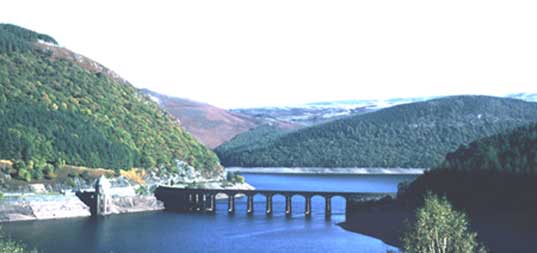| During the 19th century, at the time of the Industrial Revolution, Birmingham's population grew rapidly.
Clean water was in short supply and there were major epidemics of water-borne diseases including typhoid, cholera and diarrhoea.
Birmingham City Council, led by Joseph Chamberlain, set about finding a clean water supply for the City.
James Mansergh had previously identified the Elan and Claerwen Valleys' potential for water storage; the area had :-
An average annual rainfall of 1830mm.
Narrow downstream valleys which made building the dams easier.
Impermeable bedrock preventing the water seeping away.
Altitude - the area is mostly higher than Birmingham enabling the water to be transported by gravity, without needing to be pumped.
The Birmingham Corporation agreed and an Act of Parliament was passed for the compulsory purchase of the total water catchment area of the Elan and Claerwen Valleys (180 square kilometres).
In 1893 the building work began.
100 occupants of the Elan Valley had to move, only landowners received compensation payments. Many buildings were demolished, 3 manor houses, 18 farms, a school and a church (which was replaced by the corporation as the Nantgwyllt Church).
A railway line was constructed to transport the workers and thousands of tonnes of building material each day. This took three years.
A village of wooden huts was purpose built to house most of the workers on the site of the present Elan Village
New workers spent a night in the dosshouse to be deloused and examined for infectious diseases, only then were they allowed across the river to the village. Single men lived in groups of eight in a terrace house shared with a man and his wife.
A school was provided for those under 11, after this they were expected to work.
The village employed a guard to look out for illegal importation of liquor and unauthorised visitors.
There was a hospital for injuries and an isolation hospital. A bath house which the men could use up to 3 times a week but the women only once!
The pub was for men only. Other facilities included a library, public hall, shop and canteen. There was even street lighting (powered by hydroelectric generators). There are now hydroelectric turbines at the base of all the dams and one in the Foel Tower. The total maximum energy output is 4.6 megawatts.
The dams were built in two phases, firstly construction in the Elan Valley and later the Claerwen. The foundations of Dol-y-mynach dam were laid in phase one as the site would have flooded once Caban Coch had filled up.
Local rock was only suitable for use inside of the dams. The hand chiselled facing stones were transported from Glamorgan.
In July 1904 King Edward VII and Queen Alexandra opened the Elan dams and water started flowing along 118 km of pipeline to Birmingham.
The whole of the Elan scheme had cost �6 million and employed 50,000 men in total.
Water is extracted from the Foel Tower to the Severn Trent water treatment works. It is cleaned by rapid gravity filter sand beds. Chlorine, fluoride and lime (to neutralise the acidic water) are added.
The Foel Tower stands 52m above the Frankley Reservoir in Birmingham. The gradient of the aqueduct which links them averages 1 in 2,300, which allows the water to flow by gravity alone.
|

